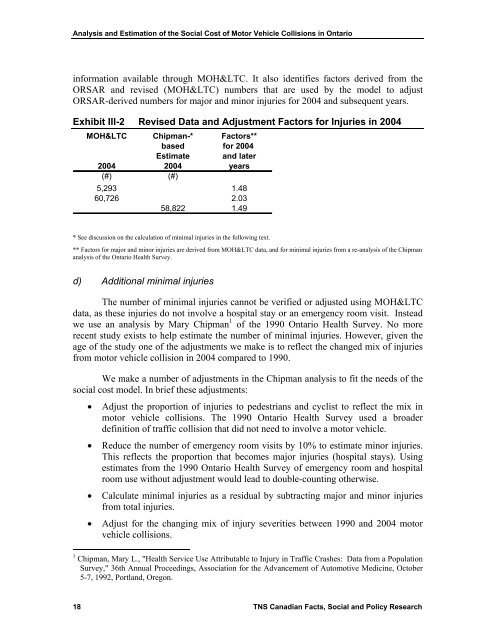Keith Vodden Dr. Douglas Smith - Transports Canada
Keith Vodden Dr. Douglas Smith - Transports Canada
Keith Vodden Dr. Douglas Smith - Transports Canada
Create successful ePaper yourself
Turn your PDF publications into a flip-book with our unique Google optimized e-Paper software.
Analysis and Estimation of the Social Cost of Motor Vehicle Collisions in Ontario<br />
information available through MOH<C. It also identifies factors derived from the<br />
ORSAR and revised (MOH<C) numbers that are used by the model to adjust<br />
ORSAR-derived numbers for major and minor injuries for 2004 and subsequent years.<br />
Exhibit III-2 Revised Data and Adjustment Factors for Injuries in 2004<br />
MOH<C Chipman-* Factors**<br />
based for 2004<br />
Estimate and later<br />
2004 2004 years<br />
(#) (#)<br />
5,293 1.48<br />
60,726 2.03<br />
58,822 1.49<br />
* See discussion on the calculation of minimal injuries in the following text.<br />
** Factors for major and minor injuries are derived from MOH<C data, and for minimal injuries from a re-analysis of the Chipman<br />
analysis of the Ontario Health Survey.<br />
d) Additional minimal injuries<br />
The number of minimal injuries cannot be verified or adjusted using MOH<C<br />
data, as these injuries do not involve a hospital stay or an emergency room visit. Instead<br />
we use an analysis by Mary Chipman 1 of the 1990 Ontario Health Survey. No more<br />
recent study exists to help estimate the number of minimal injuries. However, given the<br />
age of the study one of the adjustments we make is to reflect the changed mix of injuries<br />
from motor vehicle collision in 2004 compared to 1990.<br />
We make a number of adjustments in the Chipman analysis to fit the needs of the<br />
social cost model. In brief these adjustments:<br />
• Adjust the proportion of injuries to pedestrians and cyclist to reflect the mix in<br />
motor vehicle collisions. The 1990 Ontario Health Survey used a broader<br />
definition of traffic collision that did not need to involve a motor vehicle.<br />
• Reduce the number of emergency room visits by 10% to estimate minor injuries.<br />
This reflects the proportion that becomes major injuries (hospital stays). Using<br />
estimates from the 1990 Ontario Health Survey of emergency room and hospital<br />
room use without adjustment would lead to double-counting otherwise.<br />
• Calculate minimal injuries as a residual by subtracting major and minor injuries<br />
from total injuries.<br />
• Adjust for the changing mix of injury severities between 1990 and 2004 motor<br />
vehicle collisions.<br />
1 Chipman, Mary L., "Health Service Use Attributable to Injury in Traffic Crashes: Data from a Population<br />
Survey," 36th Annual Proceedings, Association for the Advancement of Automotive Medicine, October<br />
5-7, 1992, Portland, Oregon.<br />
18 TNS Canadian Facts, Social and Policy Research
















